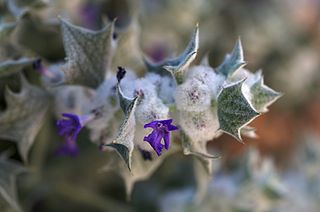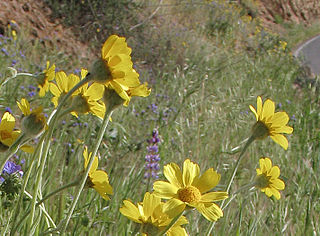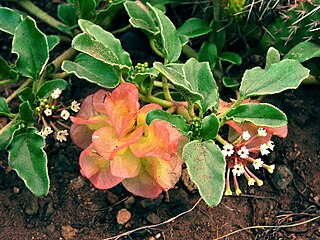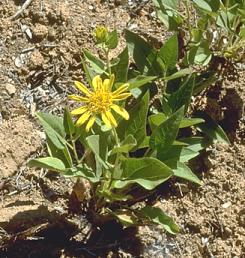
Salvia funerea, is a species of semi-deciduous perennial shrub with the common names Death Valley sage, woolly sage, and funeral sage, is an intricately branched shrub associated with limestone soils in the Mojave Desert in California and Nevada. It is characterized by an overall white appearance due to wooly hairs that cover the stems and leaves.

Bahiopsis parishii known commonly as Parish goldeneye or shrubby goldeneye, is a North American species of flowering shrubs in the sunflower family.

Viguiera is a genus of flowering plants in the sunflower family, Asteraceae. The name honours French physician L. G. Alexandre Viguier (1790–1867). It contains around 150 species, which are commonly known as goldeneyes and are native to the New World. These are herbs to bushy shrubs that bear yellow or orange daisy-like flowers.

Coreopsis calliopsidea is a species of flowering plant in the daisy family known by the common name leafstem tickseed. It is endemic to California. The plant grows in some of the southern coastal mountain ranges and Transverse Ranges and the Mojave Desert from Alameda and Inyo Counties south to Riverside County.

Allium parishii is an uncommon species of wild onion known by the common name Parish's onion. It is native to the Mojave Desert and Sonoran Deserts of California and Arizona. It grows on open dry, rocky slopes at elevations of 900–1,400 m (3,000–4,600 ft).

Arctomecon merriamii is a species of poppy known by several common names, including desert bearpoppy, white bearpoppy, and great bearclaw poppy. It is native to the Mojave Desert of California and Nevada.

Blepharizonia plumosa is a California species of tarweed known by the common name big tarweed. It is endemic to central California, where it grows in the Central Coast Ranges and adjacent sections of the southern San Francisco Bay Area and Central Valley, from southern Sonoma County south as far as San Luis Obispo County.

Lessingia glandulifera is a species of flowering plant in the family Asteraceae known by the common name valley lessingia. It is native to California and Baja California, where it grows in several types of habitat, from forest and desert to the coastline. This is an annual herb varying in maximum size from under 10 to nearly 80 centimeters in height, growing erect to decumbent. It is hairless to very hairy and glandular. The leaves are widely lance-shaped and toothed, the lowest approaching 11 centimeters in maximum length. The upper leaves are often studded with knobby glands. The flower heads appear singly at the tips of the stem branches. Each head is lined with phyllaries covered in large glands and sometimes many hairs. The head is discoid, containing no ray florets but many funnel-shaped disc florets with lobes that resemble ray florets. The disc florets are yellow with brown throats. The fruit is an achene with a whitish pappus.

Monolopia lanceolata, the hillside daisy or common monolopia, is a species of flowering plant in the famiily Asteraceae. It is endemic to the southern half of California, where it grows in many types of habitat, including coastal and valley grassland, chaparral, woodland, and desert.

Plagiobothrys canescens is a species of flowering plant in the borage family known by the common name valley popcornflower. It is endemic to California, where it is a common wildflower in valley, foothill, desert, coastline, and canyon habitat in the central and southern regions of the state.

Acleisanthes nevadensis is a species of flowering plant in the four o'clock family known by the common names desert moonpod and desert wing-fruit. It is native to a section of the southwestern United States encompassing southern Nevada and adjacent corners of Utah and Arizona. One occurrence has been observed in eastern California. The plant grows in desert habitat such as scrub and rocky washes. This herb produces several spreading stems up to about 30 centimeters in maximum length, sometimes from a woody base. The stems are covered in many leaves with fleshy oval or rounded blades up to 3 centimeters long which are borne on petioles. The herbage of the plant is coated in thick, wide, white, furry hairs, interspersed with shorter, flat hairs. Some hairs are glandular. Flowers occur in leaf axils. Each is a trumpet-shaped bloom with a narrow, tubular green throat up to 4 centimeters long and a round white corolla face about a centimeter wide, sometimes tinged yellow or greenish. There are five long, protruding stamens and a long style tipped with a spherical stigma. The fruit is a ribbed, hairy body with five broad, white wings.

Solidago multiradiata is a species of goldenrod known by the common names Rocky Mountain goldenrod, northern goldenrod, and alpine goldenrod. It is native to North America, where it can be found throughout the northern regions, including Alaska and most of Canada (all 3 territories plus all provinces except Prince Edward Island, including territory north of the Arctic Circle. Its distribution extends through the western United States as far south as Arizona, New Mexico, and California. It is known mostly from the subalpine and alpine climates of high mountain ranges. Its habitat includes tundra and mountain meadows.
Streptanthus drepanoides is an uncommon species of flowering plant in the mustard family known by the common name sicklefruit jewelflower. It is endemic to California, where it is known from a scattered distribution throughout several mountain ranges in the northern part of the state, including the Klamath Mountains. It is a resident of chaparral and woodlands, generally on serpentine soils. It is an annual herb producing a mostly hairless, waxy stem up to 40 or 45 centimeters tall. The ephemeral basal leaves have round or oval blades, sometimes edged with teeth. Leaves higher on the stem have fleshy oval blades that clasp the stem, the lower ones each measuring up to 9 centimeters long by 7.5 wide. Flowers occur at intervals along the upper stem. Each has an urn-shaped calyx of greenish or yellowish sepals under a centimeter long with whitish or purplish, purple-veined petals emerging from the tip. The fruit is a straight or sickle-shaped curving silique up to 9 centimeters long.

Tripterocalyx micranthus is a species of flowering plant in the four o'clock family known by the common names smallflower sandverbena and small-flowered sand-verbena.

Bahiopsis laciniata is a species of flowering plant in the aster family known by the common names San Diego County sunflower, San Diego viguiera and tornleaf goldeneye. It is native to the deserts and dry mountain slopes of northwestern Mexico, its distribution extending north as far as Ventura County, California.

Agnorhiza reticulata, known by the common name El Dorado County mule's ears, is a rare species of flowering plant found only in a small region of north-central California.
Toxicoscordion brevibracteatum is a species of flowering plant known by the common name desert deathcamas. It is native to Baja California, Sonora, and California, where it grows in sandy desert habitat among creosote and Joshua trees.

Toxicoscordion paniculatum is a species of flowering plant known by the common names foothill deathcamas, panicled death-camas, and sand-corn. It is widely distributed across much of the western United States, especially in the mountains and deserts of the Great Basin region west of the Rocky Mountains. It grows in many types of habitat, including sagebrush plateau, grasslands, forests, and woodlands, etc.
Boechera yorkii is a rare species of flowering plant in the mustard family known by the common name Last Chance rockcress. It is endemic to Inyo County, California, where it is known only from the Last Chance Range in Death Valley National Park. There are only two occurrences known, but the plant occurs in remote, nearly inaccessible mountain territory, so more plants may exist unobserved. The species was only described to science in 2004. Its habitat is rocky mountain canyons on cliffs of dolomite.

Bahiopsis is a genus of North American flowering plants in the sunflower tribe within the daisy family. It is native to the southwestern United States and northwestern Mexico, with several of the species endemic to the Baja California Peninsula.

















